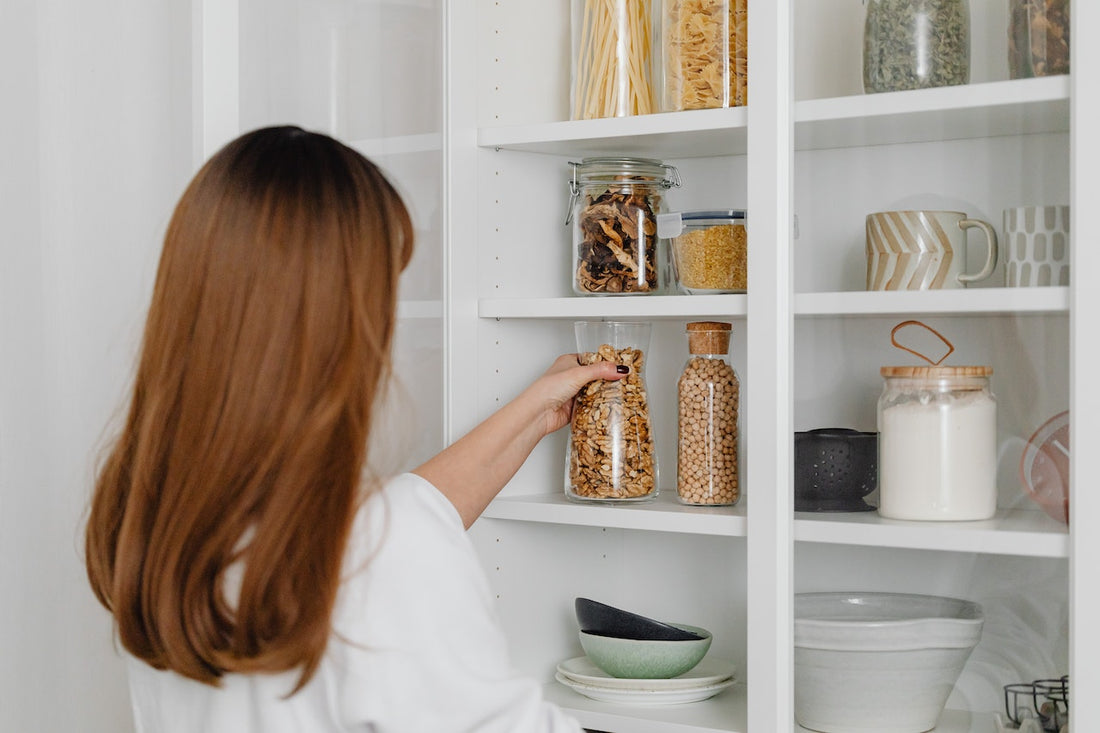Have you ever wondered about why you might have difficulties with kitchen storage and what you may not use or struggle to store effectively?
Do You Keep Things 'Just in Case'? My Little Hoarding Story!"
Storing things away, thinking you might need them someday - oh, it's a habit we all know, isn't it? My husband used to tease me, calling me a 'hoarder,' but I'd just laugh it off. Until one day, my kitchen turned into a jigsaw puzzle, and I couldn't find space for my essentials! That's when I realized it was time for a change – keep only what I truly use.
Minimizing your stuff can be quite the adventure in decluttering, and yes, it's a bit tricky. But it's the secret sauce to make room for your most cherished things. Here's why this 'cleanse' is a game-changer:
Why We're Doing This:
- Ever noticed how when your living space is sorted, your life seems to fall into place too? It's like magic! You let go of stuff, and life figures itself out.
- And to make room for the shiny and new, you've got to say goodbye to the old and unnecessary.
Why We're Ditching the Clutter:
- Let's be real; a cluttered home is never a comfy home. All those extra things? They're energy vampires. You might not notice it, but irritation, guilt, and a case of the blahs tend to pile up.
- Oh, and cleaning? Takes eons! Blame it on all those knick-knacks getting in the way.
- Plus, letting go of the unnecessary stuff sparks change! You get to know yourself better, prioritize like a champ, and all these brilliant ideas start popping up.
No Illusions of Order Here: See, we've all tried to shove stuff out of sight, only to have it sneak back into our lives later on.
1. Products: People often struggle with storage because they buy more food items than they can consume before they expire. Overcrowded pantries and refrigerators can lead to food wastage.
2. Recipe Books: Many people accumulate a collection of recipe books, some of which they rarely use. These books can take up valuable shelf space.
3. Techniques: Kitchen appliances or techniques that are rarely used may be stored away, taking up space. People might not be comfortable using them or may lack the time to do so.
4. Dishes: An excessive number of dishes, especially specialized or seasonal ones, can lead to storage problems.
5. Inconvenient Utensils: Kitchen utensils that are awkwardly shaped, difficult to clean, or are seldom used can create storage challenges.
6. Nozzles, Covers, Incomprehensible Details: Small, specialized kitchen accessories or parts of appliances can be easy to misplace, leading to disorganization.
To address kitchen storage issues, it's helpful to regularly declutter, organize, and prioritize essential items. Donate or discard items that are rarely used or no longer needed. Using clear containers, labeling, and maximizing vertical and hidden storage space can also improve kitchen organization.
Getting Ready for the Great Cleanout:
- Set aside some quality time for this adventure.
- Find a comfy spot for the grand sort-out (a bed or table will do just fine).
- Grab some bags or boxes to stuff those 'unwanted' things in – and don't forget to give them funny names, and even include your kids in the process!

Making the Call – Keep or Toss: All right, this is where the magic happens. Ask yourself these questions:
- When did I last actually use this thing?
- Seriously, do I need five of these?
- Do I have something even cooler that does the same job?
- Which one of these is my absolute fave?
- Is it broken or just sooo yesterday?
- What if this thing magically disappeared – would life be any different?
- Why does this thing still hang around my place?
So let's dive in, have some fun, and make space for the good stuff! Trust me, it's like a breath of fresh air for your home and your spirit. 😄
And here are some tips for your to organise your kitchen even better.
1. Buy in Bulk
Buying ingredients in bulk and in season saves you money and is also better for the environment. Think berries for jams, pumpkins for homemade pie filling, fresh basil for pesto, or nuts for homemade nut butters, nut milks and flours. By the way, check out our store for plant milk which you can purchase in bulk and save some bucks for yourself.

Store ingredients in their whole form for endless possibilities
Keep granulated sugar in your pantry and then grind it into icing sugar when needed. Or make your own flour mixtures from whole grains. If you’ve got more rice than you know what to do with, start thinking outside the box in terms of milling some rice into rice flour for use in different desert recipes. I do that all the time in my Thermomix cooking machine. If you would like to know more about this wonder all-in-one cooking machine, you are welcome to schedule a private demo at the convenience or your home. No obligations come with it. I love all the great things and I m more than happy sharing them with you. If you want to find out more details on this demo, click here.
Have sauces ready to go for quick dinners
Your Thermomix® is your superpower when it comes to sauces. Whether it’s a curry, pasta sauce, or pesto you have the choice to easily make it from scratch.
Buy whole spices
Keep spices fresher for longer by buying them in their whole form. Always grind your own ingredients as needed to retain their freshness and flavor, then store and use them later.Always know what you have on hand
Have you come across mysterious mason jars in your pantry? An organized labelling system will help keep track of contents and best before dates. Choose one or two items to make at home each week and you’ll soon have a pantry brimming with homemade goods.

And if you have been diagnosed with celiac decease or gluten-free sensitivity and wonder where do you start your gluten-free jorney?
- Organise your kitchen to prevent cross-contamination and ensure a safe gluten-free environment.
Here's a step-by-step guide to organizing a gluten-free kitchen:
1. Clean and Deep Clean:
- Start with a thorough cleaning of your kitchen. This includes appliances, utensils, surfaces, and all storage areas. Remove any remnants of gluten-containing products.
2. Separate Storage:
- Designate specific shelves or cabinets for gluten-free items. Ideally, these should be in higher or lower areas to prevent crumbs from falling onto them.
3. Label Everything:
- Label gluten-free items clearly to prevent mix-ups. Use colored stickers, markers, or labels. This is especially important for shared items like condiments or spreads.
4. Use Separate Utensils and Cookware:
- Have dedicated utensils, cookware, and kitchen equipment for gluten-free cooking. This includes cutting boards, toasters, and baking sheets.
5. Gluten-Free Pantry Staples:
- Stock your pantry with gluten-free staples like rice, gluten-free pasta, gluten-free flour, and other alternatives to common wheat-based products.
6. Bulk Foods and Grains:
- If you have bulk foods or grains, ensure they are gluten-free. Use separate containers and clearly label them.
7. Avoid Cross-Contamination:
- Be vigilant about cross-contamination. Use separate toasters, or toaster bags, and have separate butter or spreads to avoid crumbs. Thoroughly clean surfaces after preparing gluten-containing meals.
8. Safe Storage of Baking Ingredients:
- Keep gluten-free flours and ingredients in airtight containers to prevent contamination from airborne flour particles.
9. Separate Sponges and Towels:
- Use separate sponges, dishcloths, and towels for gluten-free and gluten-containing dishes. This prevents gluten from spreading during washing.
10. Gluten-Free Meal Preparation: - Prepare gluten-free meals before gluten-containing ones to reduce the risk of cross-contamination.
11. Check Labels: - Always read food labels carefully. Look out for gluten-containing ingredients like wheat, barley, rye, and their derivatives.
12. Educate Family and Guests: - Ensure that your family members and guests understand the importance of maintaining a gluten-free environment to avoid accidental contamination.
13. Store and Handle Leftovers Carefully: - Store gluten-free leftovers in clearly marked containers. Reheat them in an oven, microwave, or on a stovetop rather than using a shared toaster.
14. Regularly Reassess and Reorganize: - Periodically review and reorganize your kitchen to ensure it remains gluten-free. As new items are added, double-check labels and segregation.
15. Keep Gluten-Free Snacks: - Always have a supply of gluten-free snacks on hand to curb cravings and avoid reaching for gluten-containing snacks.
By following these steps, you can create a safe and organized gluten-free kitchen, reducing the risk of cross-contamination and allowing you to enjoy your meals with peace of mind.



